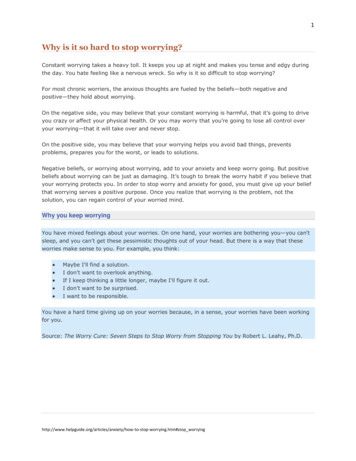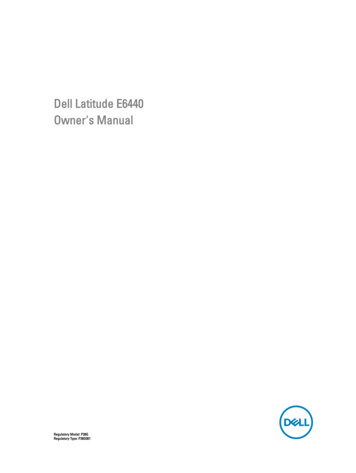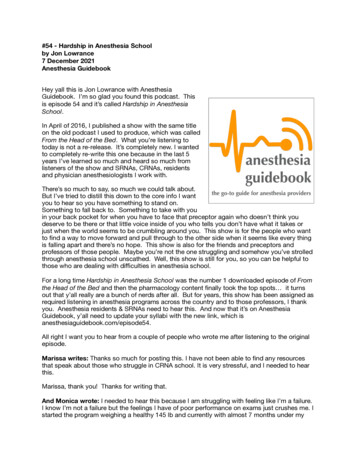
Transcription
1Why is it so hard to stop worrying?Constant worrying takes a heavy toll. It keeps you up at night and makes you tense and edgy duringthe day. You hate feeling like a nervous wreck. So why is it so difficult to stop worrying?For most chronic worriers, the anxious thoughts are fueled by the beliefs—both negative andpositive—they hold about worrying.On the negative side, you may believe that your constant worrying is harmful, that it’s going to driveyou crazy or affect your physical health. Or you may worry that you’re going to lose all control overyour worrying—that it will take over and never stop.On the positive side, you may believe that your worrying helps you avoid bad things, preventsproblems, prepares you for the worst, or leads to solutions.Negative beliefs, or worrying about worrying, add to your anxiety and keep worry going. But positivebeliefs about worrying can be just as damaging. It’s tough to break the worry habit if you believe thatyour worrying protects you. In order to stop worry and anxiety for good, you must give up your beliefthat worrying serves a positive purpose. Once you realize that worrying is the problem, not thesolution, you can regain control of your worried mind.Why you keep worryingYou have mixed feelings about your worries. On one hand, your worries are bothering you—you can'tsleep, and you can't get these pessimistic thoughts out of your head. But there is a way that theseworries make sense to you. For example, you think: Maybe I'll find a solution.I don't want to overlook anything.If I keep thinking a little longer, maybe I'll figure it out.I don't want to be surprised.I want to be responsible.You have a hard time giving up on your worries because, in a sense, your worries have been workingfor you.Source: The Worry Cure: Seven Steps to Stop Worry from Stopping You by Robert L. Leahy, -to-stop-worrying.htm#stop worrying
2Worry and anxiety self-help tip #1: Create a worry periodIt’s tough to be productive in your daily life when anxiety and worry are dominating your thoughts.But what can you do? If you’re like many chronic worriers, your anxious thoughts feel uncontrollable.You’ve tried lots of things, from distracting yourself, reasoning with your worries, and trying to thinkpositive, but nothing seems to work.Why trying to stop anxious thoughts doesn’t workTelling yourself to stop worrying doesn’t work—at least not for long. You can distract yourself orsuppress anxious thoughts for a moment, but you can’t banish them for good. In fact, trying to do sooften makes them stronger and more persistent.You can test this out for yourself. Close your eyes and picture a pink elephant. Once you can see thepink elephant in your mind, stop thinking about it. Whatever you do, for the next five minutes, don’tthink about pink elephants!How did you do? Did thoughts of pink elephants keep popping in your brain?“Thought stopping” backfires because it forces you to pay extra attention to the very thought youwant to avoid. You always have to be watching for it, and this very emphasis makes it seem evenmore important.But that doesn’t mean there’s nothing you can do to control your worry. You just need to try adifferent approach. This is where the strategy of postponing worrying comes in. Rather than trying tostop or get rid of an anxious thought, give yourself permission to have it, but put off thinking anymore about it until later.Learn to postpone worrying1. Create a “worry period.” Choose a set time and place for worrying. It should be the sameevery day (e.g. in the living room from 5:00 to 5:20 p.m.) and early enough that it won’tmake you anxious right before bedtime. During your worry period, you’re allowed to worryabout whatever’s on your mind. The rest of the day, however, is a worry-free zone.2. Postpone your worry. If an anxious thought or worry comes into your head during the day,make a brief note of it on paper and postpone it to your worry period. Remind yourself thatyou’ll have time to think about it later, so there’s no need to worry about it right now. Save itfor later and continue to go about your day.3. Go over your “worry list” during the worry period. Reflect on the worries you wrotedown during the day. If the thoughts are still bothering you, allow yourself to worry aboutthem, but only for the amount of time you’ve specified for your worry period. If the worriesdon’t seem important any more, cut your worry period short and enjoy the rest of your to-stop-worrying.htm#stop worrying
3Postponing worrying is effective because it breaks the habit of dwelling on worries in the presentmoment. Yet there’s no struggle to suppress the thought or judge it. You simply save it for later. Asyou develop the ability to postpone your anxious thoughts, you’ll start to realize that you have morecontrol over your worrying than you think.Worry and anxiety self-help tip #2: Ask yourself if the problem issolvableResearch shows that while you’re worrying, you temporarily feel less anxious. Running over theproblem in your head distracts you from your emotions and makes you feel like you’re gettingsomething accomplished. But worrying and problem solving are two very different things.Problem solving involves evaluating a situation, coming up with concrete steps for dealing with it, andthen putting the plan into action. Worrying, on the other hand, rarely leads to solutions. No matterhow much time you spend dwelling on worst-case scenarios, you’re no more prepared to deal withthem should they actually happen.Distinguish between solvable and unsolvable worriesIf a worry pops into your head, start by asking yourself whether the problem is something you canactually solve. The following questions can help: Is the problem something you’re currently facing, rather than an imaginary what-if?If the problem is an imaginary what-if, how likely is it to happen? Is your concern realistic?Can you do something about the problem or prepare for it, or is it out of your control?Productive, solvable worries are those you can take action on right away. For example, if you’reworried about your bills, you could call your creditors to see about flexible payment options.Unproductive, unsolvable worries are those for which there is no corresponding action. “What if I getcancer someday?” or “What if my kid gets into an accident?”If the worry is solvable, start brainstorming. Make a list of all the possible solutions you can think of.Try not to get too hung up on finding the perfect solution. Focus on the things you have the power tochange, rather than the circumstances or realities beyond your control. After you’ve evaluated youroptions, make a plan of action. Once you have a plan and start doing something about the problem,you’ll feel much less worried.Dealing with unsolvable worriesBut what if the worry isn’t something you can solve? If you’re a chronic worrier, the vast majority ofyour anxious thoughts probably fall in this camp. In such cases, it’s important to tune into iety/how-to-stop-worrying.htm#stop worrying
4As previously mentioned, worrying helps you avoid unpleasant emotions. Worrying keeps you in yourhead, thinking about how to solve problems rather than allowing yourself to feel the underlyingemotions. But you can’t worry your emotions away. While you’re worrying, your feelings aretemporarily suppressed, but as soon as you stop, the tension and anxiety bounces back. And then,you start worrying about your feelings, “What’s wrong with me? I shouldn’t feel this way!”The only way out of this vicious cycle is by learning to embrace your feelings. This may seem scary atfirst because of negative beliefs you have about emotions. For example, you may believe that youshould always be rational and in control, that your feelings should always make sense, or that youshouldn’t feel certain emotions, such as fear or anger.The truth is that emotions—like life—are messy. They don’t always make sense and they’re not alwayspleasant. But as long as you can accept your feelings as part of being human, you’ll be able toexperience them without becoming overwhelmed and learn how to use them to your advantage. Thefollowing tips will help you find a better balance between your intellect and your emotions.Worry and anxiety self-help tip #3: Accept uncertaintyThe inability to tolerate uncertainty plays a huge role in anxiety and worry. Chronic worriers can’tstand doubt or unpredictability. They need to know with 100 percent certainty what’s going to happen.Worrying is seen as a way to predict what the future has in store—a way to prevent unpleasantsurprises and control the outcome. The problem is, it doesn’t work.Thinking about all the things that could go wrong doesn’t make life any more predictable. You mayfeel safer when you’re worrying, but it’s just an illusion. Focusing on worst-case scenarios won’t keepbad things from happening. It will only keep you from enjoying the good things you have in thepresent. So if you want to stop worrying, start by tackling your need for certainty and immediateanswers.Challenging intolerance of uncertainty: The key to anxiety reliefAsk yourself the following questions and write down your responses. See if you can come to anunderstanding of the disadvantages and problems of being intolerant of uncertainty. Is it possible to be certain about everything in life? Do you tend to predict bad things will happen just because they are uncertain? Is this areasonable thing to do? What is the likelihood of positive or neutral outcomes? Is it possible to live with the small chance that something negative may happen, given itslikelihood is very low?What are the advantages of requiring certainty, versus the disadvantages? Or, how is needingcertainty in life helpful and unhelpful?Adapted from: Accepting Uncertainty, Centre for Clinical iety/how-to-stop-worrying.htm#stop worrying
5Worry and anxiety self-help tip #4: Challenge anxious thoughtsIf you suffer from chronic anxiety and worries, chances are you look at the world in ways that make itseem more dangerous than it really is. For example, you may overestimate the possibility that thingswill turn out badly, jump immediately to worst-case scenarios, or treat every negative thought as if itwere fact. You may also discredit your own ability to handle life’s problems, assuming you’ll fall apartat the first sign of trouble. These irrational, pessimistic attitudes are known as cognitive distortions.Although cognitive distortions aren’t based on reality, they’re not easy to give up. Often, they’re partof a lifelong pattern of thinking that’s become so automatic you’re not even completely aware of it. Inorder to break these bad thinking habits and stop the worry and anxiety they bring, you must retrainyour brain.Start by identifying the frightening thought, being as detailed as possible about what scares or worriesyou. Then, instead of viewing your thoughts as facts, treat them as hypotheses you’re testing out. Asyou examine and challenge your worries and fears, you’ll develop a more balanced perspective.Stop worrying by questioning the worried thought What’s the evidence that the thought is true? That it’s not true?Is there a more positive, realistic way of looking at the situation?What’s the probability that what I’m scared of will actually happen?If the probability is low, what are some more likely outcomes?Is the thought helpful? How will worrying about it help me and how will it hurt me?What would I say to a friend who had this worry?Cognitive Distortions that Add to Anxiety, Worry, and StressAll-or-nothing thinking – Looking at things in black-or-white categories, with no middle ground.“If I fall short of perfection, I’m a total failure.”Overgeneralization – Generalizing from a single negative experience, expecting it to hold trueforever. “I didn’t get hired for the job. I’ll never get any job.”The mental filter – Focusing on the negatives while filtering out all the positives. Noticing theone thing that went wrong, rather than all the things that went right.Diminishing the positive – Coming up with reasons why positive events don’t count. “I did wellon the presentation, but that was just dumb how-to-stop-worrying.htm#stop worrying
6Cognitive Distortions that Add to Anxiety, Worry, and StressJumping to conclusions – Making negative interpretations withoutactual evidence. You act like a mind reader, “I can tell she secretlyhates me.” Or a fortune teller, “I just know something terrible is goingto happen.”Catastrophizing – Expecting the worst-case scenario to happen. “The pilot said we’re in for someturbulence. The plane’s going to crash!”Emotional reasoning – Believing that the way you feel reflects reality. “I feel frightened rightnow. That must mean I’m in real physical danger.”'Shoulds’ and ‘should-nots’ – Holding yourself to a strict list of what you should and shouldn’tdo and beating yourself up if you break any of the rulesLabeling – Labeling yourself based on mistakes and perceived shortcomings. “I’m a failure; anidiot; a loser.”Personalization – Assuming responsibility for things that are outside your control. “It’s my faultmy son got in an accident. I should have warned him to drive carefully in the rain.”Worry and anxiety self-help tip # 5: Be aware of how others affectyouHow you feel is affected by the company you keep, whether you’re aware of it or not. Studies showthat emotions are contagious. We quickly “catch” moods from other people—even from strangers whonever speak a word (e.g. the terrified woman sitting by you on the plane; the fuming man in thecheckout line). The people you spend a lot of time with have an even greater impact on your mentalstate. Keep a worry diary. You may not be aware of how people or situations are affecting you.Maybe this is the way it’s always been in your family, or you’ve been dealing with the stress solong that it feels normal. You may want to keep a worry diary for a week or so. Every time youstart to worry, jot down the thought and what triggered it. Over time, you’ll start to seepatterns. Spend less time with people who make you anxious. Is there someone in your life whodrags you down or always seems to leave you feeling stressed? Think about cutting back onthe time you spend with that person or establish healthier relationship boundaries. Forexample, you might set certain topics off-limits, if you know that talking about them with thatperson makes you how-to-stop-worrying.htm#stop worrying
7 Choose your confidantes carefully. Know who to talk to about situations that make youanxious. Some people will help you gain perspective, while others will feed into your worries,doubts, and fears.Worry and anxiety self-help tip #6: Practice mindfulnessWorrying is usually focused on the future—on what might happen and what you’ll do about it. Thecenturies-old practice of mindfulness can help you break free of your worries by bringing yourattention back to the present. In contrast to the previous techniques of challenging your anxiousthoughts or postponing them to a worry period, this strategy is based on observing and then lettingthem go. Together, they can help you identify where your thinking is causing problems, while helpingyou get in touch with your emotions. Acknowledge and observe your anxious thoughts and feelings. Don’t try to ignore,fight, or control them like you usually would. Instead, simply observe them as if from anoutsider’s perspective, without reacting or judging. Let your worries go. Notice that when you don’t try to control the anxious thoughts that popup, they soon pass, like clouds moving across the sky. It’s only when you engage your worriesthat you get stuck.Stay focused on the present. Pay attention to the way your body feels, the rhythm of yourbreathing, your ever-changing emotions, and the thoughts that drift across your mind. If youfind yourself getting stuck on a particular thought, bring your attention back to the presentmoment.Using mindfulness meditation to stay focused on the present is a simple concept, but it takes practiceto reap the benefits. At first, you’ll probably find that your mind keeps wandering back to yourworries. Try not to get frustrated. Each time you draw your focus back to the present, you’rereinforcing a new mental habit that will help you break free of the negative worry cycle.More help to stop worryingAnxiety Help Center: Explore the various types of anxiety disorders and their symptoms, and whatyou can do to get relief.Next step.Learn more about worry-busting relaxation techniques. If you’re a chronic worrier, relaxationtechniques such as mindfulness, deep breathing, and meditation can help. Since it’s impossible to beanxious and relaxed at the same time, strengthening your body’s relaxation response is a powerfulworry-busting tactic. Read: Relaxation Techniques for Stress ReliefAnxiety self-help Stress Management: How to Reduce, Prevent, and Cope with StressHow to Sleep Better: Tips for Getting a Good Night’s SleepHow to Start a Walking Program: Tips to Get You Walking how-to-stop-worrying.htm#stop worrying
8 Benefits of Mindfulness: Practices for Improving Emotional and Physical y/how-to-stop-worrying.htm#stop worrying
every day (e.g. in the living room from 5:00 to 5:20 p.m.) and early enough that it won't make you anxious right before bedtime. During your worry period, you're allowed to worry . So if you want to stop worrying, start by tackling your need for certainty and immediate answers. Challenging intolerance of uncertainty: The key to anxiety .











